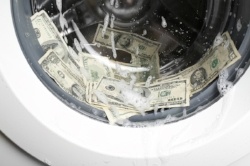Five Fast Facts about AML
 Money laundering is dirty business. One that the U.S. government has been trying to clean up since 1970. Laundering is used to hide criminal and terrorist activities by inserting "dirty" money into the legitimate financial system, "washing" it around financial institutions through transfers, until it comes out looking "clean." These ill-gotten gains can impact the global economy as much as our own. Here are some fast facts about the Anti-Money Laundering rules to help your CU take on the seedy underbelly of criminal financing.
Money laundering is dirty business. One that the U.S. government has been trying to clean up since 1970. Laundering is used to hide criminal and terrorist activities by inserting "dirty" money into the legitimate financial system, "washing" it around financial institutions through transfers, until it comes out looking "clean." These ill-gotten gains can impact the global economy as much as our own. Here are some fast facts about the Anti-Money Laundering rules to help your CU take on the seedy underbelly of criminal financing.
1. BSA vs. AML: First things first, the Bank Secrecy Act (BSA) is not the same thing as AML. The BSA was established in 1970 and is enforced by the Financial Crimes Enforcement Network, a branch of the U.S. Treasury. It established reporting and record-keeping guidelines and requires credit unions to work with the government in cases of suspected money laundering and fraud. One facet of the BSA requirements is that credit unions must follow Anti-Money Laundering rules and compliance. The purpose of the AML rules is to help detect and report suspicious activity that could be signs of money laundering schemes or terrorist financing.
2. AML Rules for CUs: The rules that specifically apply to CUs include: reporting cash transactions over $10,000, properly ID members conducting these transactions, and maintaining a clear "paper trail" with adequate and appropriate record-keeping of these transactions. Following these three credit union compliance rules helps escalate the potential laundering activities to the FINCEN to investigate.
3. Different Risk Factors: A credit union risk analysis should include assigning risk scores to their members when signing up for services as a basis for identifying anomalies in transactions. This baseline can act as a constant point of reference for your team so they can learn to recognize abnormalities. Also, certain products and services pose a higher risk for money laundering, such as electronic banking and funds transfers. Even geographic locations, such as big cities vs. rural settings, can pose a higher risk for criminal enterprise activity.
4. Know Your Members: FINRA, who reviews compliance with AML rules, sets forth minimum standards for a written AML compliance program. One aspect of compliance is having a risk-based customer identification program (CIP) that enables your credit union to form a reasonable belief that it knows the true identity of its members. This means conducting thorough background and banking history checks. Your due diligence in this regard will also be useful when it comes to assessing risk for loan products.
5. Not Just for Credit Unions: Aside from traditional financial institutions such as credit unions and banks, a variety of other institutions are required to report suspicious activity under the BSA, including money order companies, brokers, casinos, and even dealers of gemstones and precious metals. Money laundering relies on complex webs of activity, and all these points of entry and exit are susceptible to being tools of the dirty money trade.
Laundered money is untaxed and flows through our economy without actually contributing to it. Large influxes of dirty money creates false demand that signals policy makers to address by adjusting rates. When the laundering is discovered, all this cash suddenly disappears, which can be crushing to the economy and devastating to the financial sector. It is the duty of CUs to themselves, their members, and the global economy to be vigilant in following the AML rules and using credit union compliance tools to assist.


